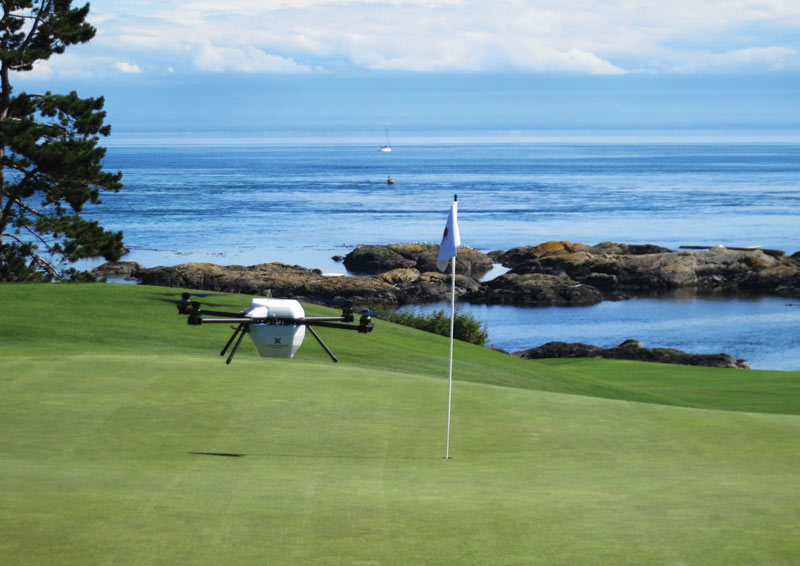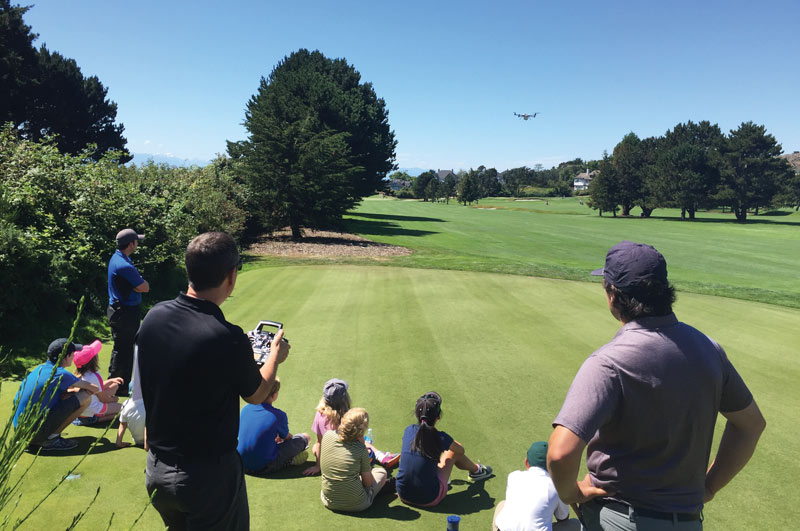
Victoria Golf Club is a seaside course and is the oldest in Canada
that still sits on its original site, having first opened for play in 1893. The club is one of a handful of sites participating in a pilot program that’s testing the agronomic applications of drone technology. Photos courtesy of Paul Robertson
Paul Robertson, superintendent of links at Victoria Golf Club in Victoria, British Columbia, is a practical man.
A few years back, he chose to pursue a master’s degree, and instead of deeply exploring something specifically agronomic, he went the project management route. “Because the club was paying for it, I thought this subject matter would mean good value for the club,” he says.
Equipped with this new degree, Robertson set about managing projects: a $1 million sea wall reconstruction, a $4.5 million irrigation and drainage installation, a new $2.5 million maintenance building and turfgrass center, and a $3 million course renovation with architect Jeff Mingay. (Clubs typically spend from 5 percent to 10 percent of a project’s total cost on hiring outside project management services. For his graduate education, Robertson has paid the club back many times over.)
Fast-forward to winter 2015. Robertson, a 21-year member of GCSAA, and his assistant superintendent, T-Jay Creamer, were planning and budgeting for the upcoming season and discussing how to improve cultural programs, specifically disease and water management.
“To more accurately schedule irrigation, we have been using Spectrum Technology’s TDR (time-domain reflectometry) units equipped with GPS, which record soil moisture tagged with the GPS coordinates of each spot sampled,” Robertson says. “We typically hire two student techs who do nothing but map the course, providing a representative idea of soil moisture. It’s very labor-intensive, gathering all that data by hand and converting it back into information you can use, just to adjust the irrigation system. Typically, we’ve been spending $10,000 a year on soil monitoring, and we were thinking, ‘There has got to be a better way.’”
Then T-Jay saw a post on Twitter about GreenSight Agronomics’ autonomous drone program. “It would map everything — every day — and shoot the course with all sorts of different cameras,” says Robertson. “I thought, ‘This is interesting.’”
Bird’s-eye view
Six months later, Robertson and Victoria GC joined five other facilities to become a main pilot site for GreenSight’s first-generation drone system. Two months after he began “flying,” Robertson saw the potential to not only relieve his staff of daily soil probing, but also to provide a daily bird’s-eye view of the entire golf course. The drone’s near-infrared and red-edge cameras, which spotlight chlorophyll, highlight all the places on the course where turf health has been compromised.
“We are speculating, but compaction seems to be most evident in the early images,” Robertson reports. “These areas are under more stress than the rest of the turf. If you look at rock formations or edges of cart paths, they are bright red. You see the same color on the walk-off areas of greens. I suspect compaction is reducing soil-pore space, decreasing soil oxygen and reducing water penetration. That’s very hard to see from the ground across the entire course. However, after a 20-minute flight, it is obvious we have a problem.”
The big turf disease issues at seaside Victoria GC, according to Robertson, are Microdochium patch in winter and anthracnose in summer. Over last summer, Robertson and Creamer crafted operations in hopes of seeing where focused spot-treatment programs would lead to color changes in the drone photography. By this spring, he hopes to have enough data to detect soil temperature and moisture levels, “to take our irrigation practices to the next level.”
“To be honest, that’s why we bought in — to tailor our irrigation,” Robertson says. “We’d love to eliminate the soil probing, but that’s just labor. Our water costs are $80,000 to $100,000 a year, and water rates in our part of the world are increasing rapidly. I can see a potential 20 percent savings in water. Reductions in pesticides, fertilizer and labor are secondary benefits. For example, if we can reduce pesticide applications through spot treatments, we could save an additional $10,000 to $20,000 annually, and it’s the right thing to do.”
‘Creating the science’
GreenSight Agronomics is Boston-based and staffed almost exclusively with former defense contractors whose expertise was honed deploying reconnaissance drones in Afghanistan. Justin McClellan, for example, the company’s chief marketing officer, holds a Bachelor of Science in aerospace engineering from Boston University, along with an MBA. Before forming GreenSight, he led a reconnaissance satellite research and development program for the Defense Advanced Research Projects Agency, part of the U.S. Department of Defense.
McClellan reports that pilot programs like Robertson’s are currently underway at Desert Mountain in Arizona, two “high-profile private clubs” on Long Island that requested anonymity, and Trump National Golf Club in Bedminster, N.J., in addition to a pair of agrochemical company test sites. The results, he says, have been striking, but it’s important not to outrun the scientific process or the evolving technology.
“It’s tricky because no one has done this before,” McClellan says. “When we start looking for aerial evidence of fairy ring with a thermal camera, we can’t just research existing science. We’re creating the science here, and it can be a slow process.
“Our pilot customers like Paul are getting in early on this,” he says, adding that a thermal camera to accurately measure turf temperature was slated to be introduced by the end of 2016, when as many as 30 early-adopter customers were expected. “By April (2017), we’ll roll out a more complete system that will have moisture maps, not just temperature maps. We should be able to detect fungal infections from the day-to-day maps, so we can shoot customers email alerts telling them they need to act.”

The drone at Victoria Golf Club has proved quite the attraction. Superintendent Paul Robertson has scheduled its daily flights for early in the morning so he and his team can focus on the task at hand.
“Ultimately,” says John Kaminski, Ph.D., director of the golf turfgrass management program at Penn State and the company’s chief agronomic officer, “here’s where I’d like to see it go: These maps will be able to identify areas of disease infestation and dry spots, then integrate that info with GPS-driven sprayers and other units. They’re not quite there yet. But as we collect more information from the imagery data, we’ll start building those smart mechanisms into the systems.
“I think the strength in this approach is that flights are routinely done, on a daily basis, where you look at an entire week’s photography and see how things are changing,” Kaminski continues. “We have moisture meters that keep track of that, but to do it aerially and hit the play button to see areas where patterns start to occur? Near term, that’s a huge benefit. You will see things start to go wrong and respond way prior to what’s visible on the ground. Ultimately, the superintendent will be able to set his points and tell the system, ‘Alert me if the temperature gets above this level.’ That’s a big deal.”
At the golf course itself, the system resides in a box about 3 feet square. Each morning, the top of this box opens wide — like a pod housing some alien being — and the drone (measuring 2 feet square) fires up. Once aloft, it follows the GPS-determined path over the course footprint. The four electric motors are essentially inaudible above 150 feet. At the recommended flight altitude of between 200 and 300 feet, it’s a mere speck in the sky.
When its appointed rounds are finished, the drone performs a precision landing in the box, the pod doors close, and it rests until the next morning’s flight. Meanwhile, all the information gathered from its various multi-spectral cameras is uploaded to an internet cloud service, where it is processed and made available to the superintendent but also scrubbed by the company’s software to find changes and issues.
Sorting legal matters
The practicalities of this system would seem awfully futuristic if they weren’t already in operation at test sites like Victoria GC. Because daily drone flights are commanded remotely from GreenSight’s headquarters, its customer courses must have the requisite antennae. GreenSight supplied the antenna — “basically the same large antenna used for our irrigation system,” says Robertson, who hired an electrician to install it, along with the cable that runs from the maintenance complex roof down into the office. It was done in two hours.
GreenSight’s team arrived shortly thereafter, in early July, with a proprietary base transceiver box that both sends info to the cloud and pulls it back down. This cable-box-sized unit, containing the required radios and communications gear, lives in the office Robertson shares with his assistant and irrigation technicians.
Robertson was GreenSight Agronomics’ first North American user.
“That first week in July, they did some programming here, on-site, installed the box and instructed us regarding how to take over control of the drone if necessary,” Robertson explains. “We have a commuter plane service and Helijet operating nearby. In Canada, in that situation so close to an airport or flight path, we have to stay below 200 feet and be able to take control of the drone at any time.”

Five of the 18 holes at Victoria Golf Club sit along the Strait of Juan de Fuca, which opens to the Pacific Ocean.
Given the early version of the system and its unique proximity to manned aircraft, Robertson is more hands-on than a typical customer will be.
“We met with Nav Canada and Transport Canada to clear all this. We secured a special flight operations certificate after detailing when we’re flying, why we’re flying and who is in charge, emergency contact info, etc. They emailed back and said they wanted to see specific flight paths. So we provided that,” Robertson says.
“Eventually we agreed that we’d only fly between 6 a.m. and 8 a.m., which turned out to be best for everyone. I noticed early in the training that when you’re out with the remote, members stop you all the time and ask what you’re doing. I got interrupted 20 times in 20 minutes — and it’s hard to keep your eyes on the drone. So, it’s better to fly first thing in the morning. I can stay ahead of the golfers and don’t get interrupted.”
Changing requirements
Many superintendents have invested in and trained themselves in amateur drone operations — as have other commercial entities that have been entering the golf course management market — and much has been written about the practical legalities related to privacy and liability. The U.S. Federal Aviation Administration in August issued a series of rulings related to amateur and professional use of these drones, including a registration process.
All of this was good news for GreenSight — the stigma and questions surrounding widespread drone use in the U.S. are clearly dissipating. Indeed, the company’s subscription approach makes it that much easier for superintendents specifically, as whatever restrictions and registrations remain are included in the company’s service package.
“We are operating 100 percent within the legal framework for drone operations,” McClellan reports. “We have authorization from the FAA to operate our drones over golf courses. More important for superintendents, all legal responsibility for the drone flights rests with GreenSight. What’s more, GreenSight and our drone system are insured for injury, death or damage to property caused by the equipment under proper usage. By offering a subscription, we offload all that from the user.”
Through the end of 2016, FAA requirements obliged someone to watch the drone take off each morning. That requirement is expected to be phased out in 2017 as GreenSight’s waivers are approved.
“Some might be intimidated,” Robertson says, “but I can’t say enough about the guys at GreenSight. They walked us through all aspects of the program, and setup was easy. In two days, we were flying. If there’s any problem with the drone, they can log on in real time. Typically, we phone in at 6 a.m. when we set up; we watch it take off and we all watch it fly in real time. If they see problems, they can tell us or fix it remotely.
“We haven’t had any crashes. But this is where the subscription service makes sense. We don’t own the drone, so if it did crash, they would replace it.”
Predictable practicality
It’s instructive to listen to Robertson talk about all the information he has gathered from just the first two months of spectrographic imagery. But it’s eye-opening to listen to McClellan and Kaminski talk about just how primitive Robertson’s first-generation system is. This year, the trial program will expand to include a thermal camera, giving GreenSight, Kaminski and all trial users more information, analytics and expertise to work with. The next iteration of the system will include thermal cameras that measure leaf temperature.
“There’s some math involved there, but we can then make the jump to soil moisture measurements based on the amount a plant is sweating. The more it sweats, the more moisture in the root zone,” McClellan says.
The holy grail here is disease prediction — or, rather, a reading of this imagery that is nuanced and reliable enough to allow superintendents to see something coming and head it off at the pass.
“I can look at someone’s course and see how fairy ring moves through the course. I think when you get into predictive models for diseases, it will take more work — but we’ll get there,” Kaminski says. “When we’ve integrated this technology with weather systems, we will start picking up stuff in advance, especially with the aid of these new cameras. The pythium problems we’ve been dealing with (last summer) — I’m pretty sure if we’d been flying these courses, we’d have caught it early. Eventually, we will see the patterns.”
With predictable practicality, Robertson is not merely awaiting his thermal camera — he’s thinking about making his drone project the subject of serious agronomic study and, maybe, earning another advanced degree along the way.
“I’m not sure yet how the Ph.D. will dovetail, but the club has approved it, and Dr. Hsiang (Tom Hsiang, a professor in the School of Environmental Sciences at Ontario’s University of Guelph) has approved it in principle,” Robertson says. “But I’ve got to decide if I’m going to do it or not. I just got my master’s three years ago. I’m a little gun shy about getting back into the school thing right away.”
Hal Phillips is the managing director of golf and resorts for Mandarin Media, a public relations firm with offices in Portland, Maine; Park City, Utah; and Saigon, Vietnam. He is the former editor of Golf Course News.